COMPLEX ARQUEOLOGICO OF CHAVIN OF HUANTAR
The Chavín culture is expressed of eloquent way in the architecture of the site of Chavín, traditionally described as Chavín de Huántar, although no longer it is located in the jurisdiction of the district of Huántar but in the one of Chavín.
To give prestige to this archaeological site they contribute many monoliths carved with figures of supernatural beings, who in their majority adorned the walls of Chavín.
ARCHITECTURE
The monuments of Chavín are located in the Eastern skirts of the White mountain range to 3185 meters of altitude, in the triangle formed by the Huachecsa and the Mosna, rivers these that are united to pay their waters to the Marañón.
The magnificencia and Majesty of Chavín are so that its construction was assigned to a "race of giants" and not to common men. It registers this mythical explanation Pedro Cieza of Leon (1553), when describing what in his time it was already a "antique" left by the man.
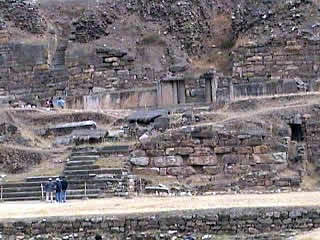
Chavín de Huántar was the hugest expression of the Chavín civilization arrival to its fullness. There we can today appreciate the rest of its temples, a set of buildings, underground terraces, platforms, seats, galleries, channels and columns, that they attest what it happened in the place does more than three thousand years.
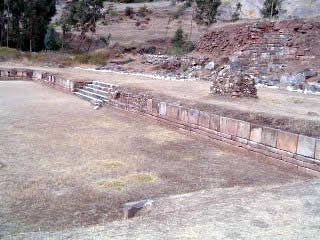
CHAVIN DE HUANTAR
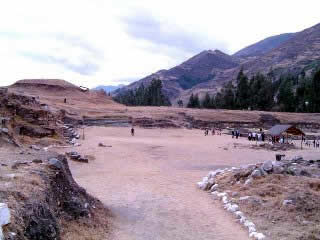
CHAVIN DE HUANTAR
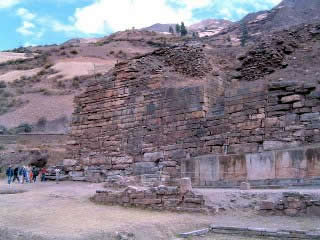
CHAVIN DE HUANTAR
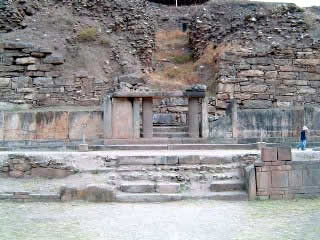
Portico and columns of the temple. By aqui tapeworm place the ascención to the top, that cubria by means of a peculiar system of perrons.
Chavín is constituted by diverse piramidales buildings, seats that are based on a aterrazada slope, covers and perrons. The piramidales constructions lodge an inner network of passages and cameras, that in some cases appear superposed. Like prime construction equipment the stone, although some sector the walls were stuccoed with clay that was calcined to resist the attacks of the time.
A particular note is conformed by portrayed stones to mythical figures in stop andrelieve. In their majority these plated walls and decorated buildings and one of the sunk seats. On the other hand, stones carved in form of heads of fierce expression went interlocked at the top of the walls, placed equidistant and in horizontal row.
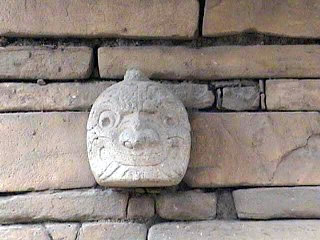
One of head-nails them that they decorate the walls of Chavín de Huántar. There are some who suppose that they can have been simbolicas imitations of heads. Its face instills respect, combines human anatomicos elements, of feline and bird.
The constructions of Chavín were elaborated starting off of a nuclear structure made with mud and stones without working, in which previously the spaces corresponding to which had been programmed they had to be running or inner passages. Monolithic walls and thresholds freed these passages from the mass of mud and constituent stones of the construction. To the artificial hill, perforated, that therefore was constructed, piramidal inclination, the one that were interrupted by steps or "platform" occurred him. Finally the whole was had in its outside with stony or spun plates primorosamente polished. The damage of the erosion is perceivable in the less resistant stones, and it causes that in appearance today some "imperfect" walls shine at sight. It is to notice that there was lack of no perfection in the construction of the bases of the outer walls of "the Castle", since this sector Lucia originally covered or plated by great stone blocks, of square tendency and which with running of the time collapsed.
In the inner passages total and perpetual penumbra but for the beams of light that penetrate by the ductos or "vents" reigns that communicate with the outside and renew the air constantly. Perhaps by these ductos the voices of oráculo of Chavín were listened to to which early writers talk about.
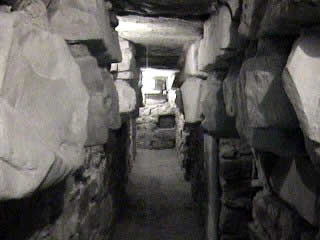
CHAVIN DE HUANTAR LABERINTO
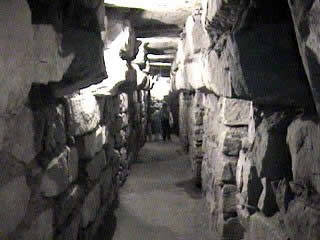
CHAVIN DE HUANTAR LABERINTO
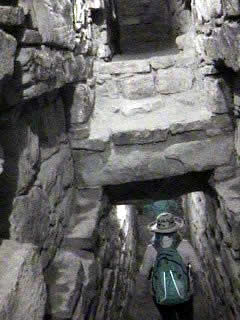
CHAVIN DE HUANTAR LABERINTO
In a sector of the internal passages yergue the Lanzón, a monolith carved with mythical figures to be seen the round one. The immense stone reaches almost 5 meters of stop and surprises to the spectator with its supernatural representations, that "instill terror" as already Antonio Raimondi expressed, to which perpetually adds the location of the monolith in the dark galleries of Chavín
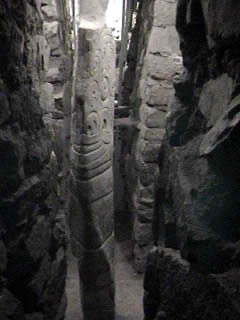
The Lanzón, is monolithic, of almost 5 ms of height, is in the call "Temple Early". Probably its form alluded to an eyetooth, the repeated emblematic element more in the beings represented in the Chavín art.
By the exposed thing, light and the dark, day and night, were represented symbolic factors in the architecture of Chavín. And not only by means of its architectonic spaces dedicated to the world exteriory to the inner or underground world, but also through the division in two halves that observe some perrons, as much as the cover of "the Castle": dark and a other clear one, and that the constructors emphasized using stones of construction of different tonality. The same iconography, shaped in many monoliths, seems to be prevailed by these symbolic poles if seconsidera that the represented supernatural beings exhibit attributes of birds of prey and of felines that, by their nature, are tie to the day and the night and respectively to the man and lahembra.
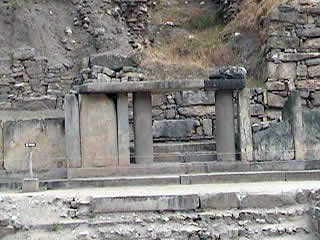
Light and the dark, day and night, were represented symbolic factors in the chavinense architecture. Their perrons also expressed the division in two halves, like the cover of "the Castle"; dark and a other clear one.
PLANNED ARCHITECTURE
It is known that the different structures that conform Chavín would correspond to diverse historical times by which crossed the site. This statement belongs to Julio C. Tello. Years later, in 1962, John H. Rowe deepened in the subject and endorsed in present tipológicas differences in monoliths secuenciade proposed one the architectonic structures. It deduced that Chavín, as it has arrived until us, was constructed starting off of a fundamental temple of modest bases: the "Old Temple". With passing of the time, this structure would have supported diverse extensions. In a stage later, that it considers was third, one would have consolidated what describes as "New Temple", of greater proportions and constructed alongside, retaining part of the structure of the monument primigenio. Rowe bases its protected hypothesis on the presence of a species of visible cracks in the walls and that consider they are vestiges of tie points of the "additions".
Nevertheless, the "cracks" that assume would have been produced by the extensions experienced from the "Old Temple", raise the suspicion that not necessarily they correspond to impronta left by successive architectonic extensions. In effect, when these are comparadascon other Andean architectonic examples in which also they appear, is stated that they are not another thing that marks printed by the technique to deconstruir on the basis of modules, is to say laterally adding sectors without it implies significant chronological separation. On the other hand, the techniques of Old construction between el"Templo" and the "New Temple" of Chavín do not present/display well-known variations. And, which still more turns out to be significant, either the same architectonic concepts and their implicit symbolic values. This way, it is possible to raise the possibility that Chavín was conceived under a single architectonic plan, and that its execution was made without a cultural nor chronological delay of consideration like separating cultural stages.
ARCHITECTURE EVOCADORADE ONE APPEARS
On the exposed premise the hypothesis is based that it looks for to identify the silhouettes of a symbolic figure in the architectonic set of Chavín, that naturally had to copy only to great outlines some conspicuas figures of the Chavín iconography, simplifying their forms when having to adapt it to the architecture.
When proposing the author in 1983 this hypothesis, on the possibility that the Chavín architecture would be evoking a zoomorfa image and when trying to correlate the diverse sectors with the anatomical parts of the supernatural being Chavín who had served as inspiration, ended up arguing which until the decoration of the walls of Chavín, with their two lines imprisoned by two of greater proportions, one down and other above, infinitum could obey to the will to appear streamlined mouths ad, by the crease which they accuse the lips for, in aggressive attitude, to leave the two rows of the set of teeth at sight.
As it is known, the iconográfico reason Chavín is the atigrada mouth, represented with extreme insistence as much in monoliths and ceramics as in objects worked in diverse materials: times under isolated treatment and/or in succession and others incorporating it like symbolic element in figures of personages.
The case of representing Chavín a figure, as we suppose, this possibility deserves more attention and study; let us consider which other examples in the architecture of the old Peru of constructions with unquestionable content exist iconográfico zoomorfo, like Paramonga and White Cerro in Nepeña. Also the architectonic plane of the Haldas, monument previous to Chavín, seems to repeat the same figure, apparently basically of a bird. The city of same Cuzco would have appeared the contours of a feline; perhaps with head of bird according to an old one and very spread Andean iconográfico pattern.
THE CHAVIN MONOLITHS
Manifest the Chavín style of eloquent way in the monolith associated to the architecture of Chavín (of Huántar). These plated, in their majority, the walls of buildings.
The more spectacular Chavín monoliths are the Raimondi Wake, the Obelisco Tello, the Lanzón and the Columns. For the mentioned examples of the lítica sculpture Chavín the Wake of Yauya must be added, no matter how hard not outside located in the site of Chavín. The figures represented in these monoliths observe accentuated degrees of estilización and are by logeneral difficult to identify. To it it contributes the one that goes splashed of an endless number of built-in figures that recharge the representation, darkening it. Also, and at first sight, the figures appear incomprehensible, because they represent beings with extracted human and zoomorfos attributes of unknown stories mythical. It has motivated that teems the diverse opinions as far as the represented thing
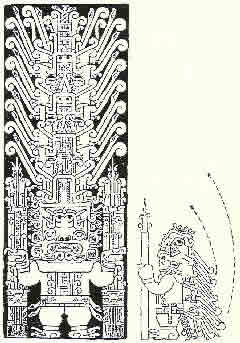
The Raimondi Wake and a interpretativa hypothesis of the appeared thing in this monolith (FKD 1968). As it suggests the drawing in which we tried to present/display the profile personage, the Raimondi wake would appear to a supernatural being of human contours with atigrada mouth and varíos ornitomorfos atríbutos: claws in feet and hands, and probably wings with streamlined plumage reduced in a single front represented body to the being and in extended space; they would go exposed, therefore, upon the head, with the purpose of power to be visualized.
Thus, some professional archaeologists maintain that the figures in monoliths of Chavín draw caymans, others see in them lobsters and third spiders, etc. The simple isolated contemplation, outside the Andean iconográfico context of which it comprises Chavín, has contributed to that this abundance of different interpretations appears. The comparative method in the study of the Andean votivas images allows to indicate, in attention represented similar beings with more clarity in later and inheriting styles of Chavín, that the represented divinity more was the one of a hybrid being: half man with atigrada mouth and half bird of prey. Naturally that the proportions of the elements vary. To this supernatural being of the Chavín pantheon we have described it, for the exposed reasons and from 1967, of piscoruna-pumapasimin (man-bird with atigrada mouth).
In other words, this archaeological flying feline could correspond to the God of the Water, that had to arise par excellence like corolario of the context of the barren Andean nature and with tribulations of atmospheric order, droughts for example. Due to the phenomenon of cultural continuity that presents/displays the Andean world, Illapa, the supernatural being controller of the meteorological phenomena of the times of the Incario, could be the delayed incarnation of the Flying Feline. The myth of Qhoa, still effective, indicates that when bursting in the storms a feline moves by clouds.
The case of the Chavin temple, like center of being able and cult, allows to infer that it was raised in a carefully chosen site, under strict criteria magician-monks.
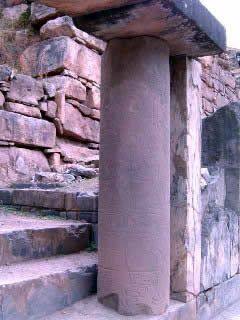
Chavin.
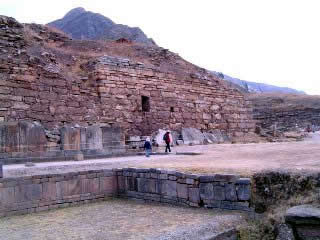
Chavin.
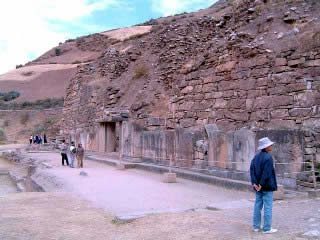
Chavin.
CHAVIN: ADMINISTRATIVE CENTER And OF CULT
When the cronista Thorny Vázquez de visited already in 1616 at that time "the ruins" of Chavín, the neighboring ones informed to him that in remote times it had been a cult center and romería. It is why it concludes comparing it with Rome or Jerusalem. In the same way, Tello insisted on the sacred character, of temple, Chavín.
Probably the same site where Chavín had to rise carefully was chosen, under strict criteria magician-monks because there are neighboring valleys more productive than the Straits of Mosna, even considering the advantage of its cultivated slopes of dry land by means of terraces. The case of Chavín, as its center to be able and cult, allows to infer that it could be raised in a place indicated by the magic, like the Cuzco, that was constructed between the brooks of the Tullumayu and Huatanay and not indeed in the very fertile neighboring valley of the Urubamba-Vilcanota.
The will to exert dominion, in order to adapt the production of foods to the rate of the increase of the population, could be the as that Chavín acted, using for the effect the administration of agricultural practices, endorsed in pompous ritual and the cult to the supernatural powers that controlled the production, specially the God of the Water on which beneficient rains like of the catastrophic droughts depended that destroyed the sementeras.
The monuments of Chavín, by their magnitude, are expressions made by a developed agrarian society, worried to satisfy the nutritional necessities with their members through ample geographic areas, as it seems to indicate it his character of center of romería. Of the same the Chavín society it had to clearly be in favor divided in two sectors: the one of the agent chief executives and the one of the governed ones. Due to it the old civilizations of the orb were able to create huge works in volume, talent and art like the one of Chavín. The abandonment of the site can be caused by the breach of the obligations assigned to the elites of guarding by the sustenance, when happening devastating climatic changes impossible to perhaps straighten with magical actions.
EPOCA INCAICA: THE EXODUS
The cultures are like the men. They age and they die. And that happened with which there was in the valley of Santa and which, apparently, there were lost all his powerful thrust when the empire of the Incas arrived at that zone.
They were the times of conquest of Able Yupanqui. They were not easy. Many towns of the valley offered aggravated resistance. According to the archaeological studies, some towns that they did not love to be put under the incaico empire preferred to emigrate in mass. In that exodus would be the origin of some selváticas tribes. One assumes that the Incas introduced the cult to the sun, because previously veneration to animals or celestial bodies was paid that appeared at night.
Source: Great Encyclopedia of Peru - Lexus.
Página web creada el 30 de marzo del 2005.
© Copyright 2005 Gualberto Valderrama C.
|
 SPANISH
SPANISH

 SPANISH
SPANISH
